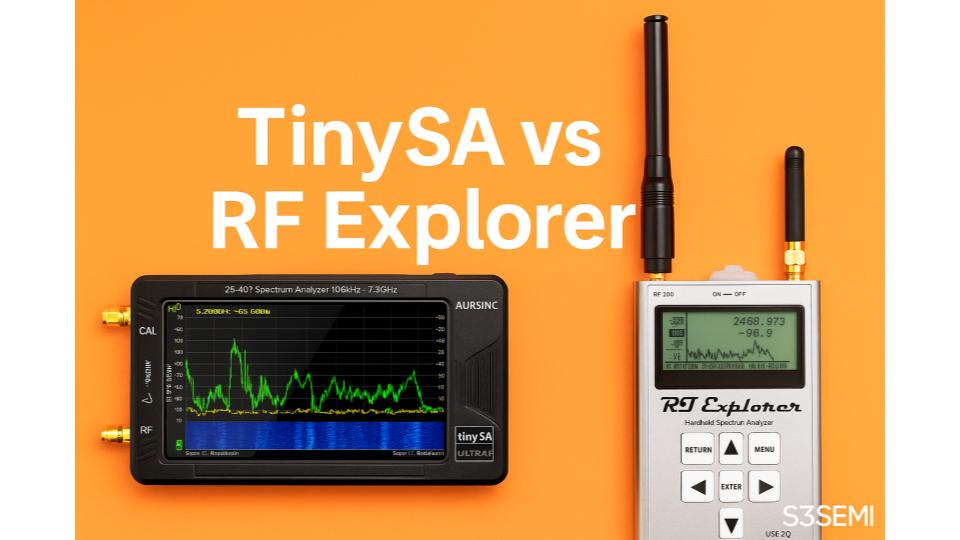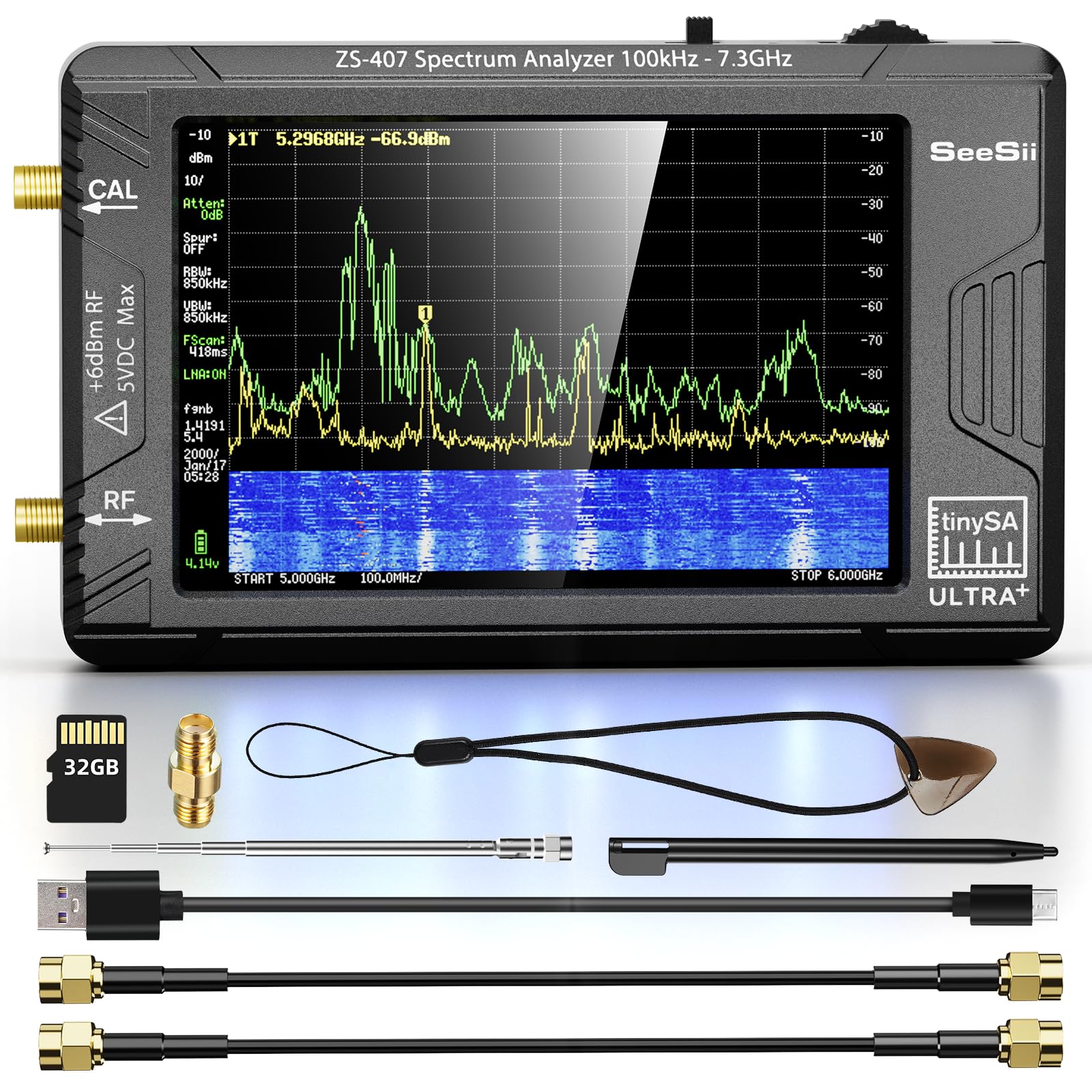Affordable spectrum analyzers like the TinySA and RF Explorer have changed the way hobbyists, ham radio operators, and RF engineers test and troubleshoot signals.
🧰 See up-to-date pricing directly on Amazon
Both devices provide accessible spectrum analysis at a fraction of the cost of lab-grade equipment, but they differ in frequency coverage, usability, and reliability.
Let’s compare the TinySA ZS407 and the RF Explorer 6G Combo to help you decide.
🔍 Overview of the TinySA ZS407
The TinySA ZS407 is part of the TinySA4 lineup and is the most advanced model, extending frequency analysis into the 7.3 GHz range. It combines spectrum analysis and signal generation in one compact unit, making it attractive for hobbyists and experimenters.
Key Features:
- Frequency range: 100 kHz – 800 MHz (normal), up to 7.3 GHz in ULTRA mode
- Built-in signal generator (sine up to 800 MHz, square/sweep modes up to 7.3 GHz)
- Touchscreen interface (4″ 480×320 display)
- Built-in LNA (20 dB, NF 5 dB) for low-signal measurements
- Noise floor as low as -145 dBm with LNA enabled
- Spur-free dynamic range: ~70 dB
- Portable with USB charging (about 2–3 hours runtime)
Community Feedback:
On forums and Reddit, users like the TinySA for its price-to-feature ratio and portability. However, it’s often described as a hobbyist tool – good for general troubleshooting, ham bands, and basic RF projects, but not always accurate enough for professional measurements.
⚡ Overview of the RF Explorer 6G Combo
The RF Explorer 6G Combo is a rugged handheld spectrum analyzer that covers a broad frequency range, making it popular with RF professionals. Unlike the TinySA, it focuses solely on analysis (no signal generator built-in), but its stability and accuracy are appreciated in the field.
Key Features:
- Frequency coverage: 15 MHz – 2.7 GHz plus 4.85 – 6.1 GHz
- Aluminum enclosure with rugged field-ready build
- Dynamic range: ~95 dB typical (noise floor to max input)
- Max input power: +25 to +30 dBm (depending on port)
- Battery life: 16+ hours per charge
- PC connectivity with open-source software
- Comes with multiple antennas for wideband coverage
Community Feedback:
On Reddit and ham forums, users highlight the RF Explorer’s ruggedness and reliability. It’s seen as more professional-grade compared to TinySA, though the interface (non-touch, 128×64 LCD) feels outdated. Users often connect it to a PC for a better experience.
📊 Comparison Table
| Feature | TinySA ZS407 | RF Explorer 6G Combo |
|---|---|---|
| Frequency Range | 100 kHz – 800 MHz, up to 7.3 GHz | 15 MHz – 2.7 GHz + 4.85–6.1 GHz |
| Signal Generator | ✅ Yes (up to 7.3 GHz) | ❌ No (separate SG model needed) |
| Display | 4″ Touchscreen, 480×320 | Non-touch LCD, 128×64 |
| Build Quality | Plastic case, lightweight | Aluminum case, rugged field unit |
| Battery Life | ~2–3 hours | 16+ hours |
| Noise Floor | Down to -145 dBm (with LNA) | ~-105 dBm typical |
| Dynamic Range | ~70 dB | ~95 dB typical |
| Max Input Power | +6 dBm (0 dB atten) / +20 dBm (30 dB atten) | +25 to +30 dBm |
| PC Connectivity | ✅ USB control | ✅ USB + open-source software |
| Portability | Compact, hobbyist-friendly | Heavier, but field-proven |
| 💳 Pricing | 💲Check Price | 💲Check Price |
✅ Pros and Cons of Each
TinySA ZS407 Pros:
- Very affordable compared to RF Explorer
- Built-in signal generator up to 7.3 GHz
- Touchscreen interface, easy to use
- LNA helps detect very weak signals
- Great for hobbyists, ham radio, and education
TinySA ZS407 Cons:
- Short battery life (2–3 hours)
- Plastic build, less rugged for field use
- Accuracy and dynamic range not as strong as professional analyzers
- Reports of calibration drift over time
RF Explorer 6G Combo Pros:
- Rugged aluminum construction, reliable for field work
- Long battery life (16+ hours)
- Wider dynamic range and better handling of strong signals
- Strong community and software support
- Multiple antennas included for sub-GHz and GHz bands
RF Explorer 6G Combo Cons:
- More expensive
- No built-in signal generator
- Small non-touch display feels outdated without PC
🏆 Verdict: TinySA ZS407 or RF Explorer 6G Combo?
Both devices serve different needs:
- The TinySA ZS407 is best if you are a hobbyist, ham operator, or student who wants an affordable spectrum analyzer with signal generation. It’s great for learning and light troubleshooting, though not always precise enough for professional compliance testing.
- The RF Explorer 6G Combo is better for RF professionals, field engineers, and advanced users who need accuracy, ruggedness, and long battery life. While it lacks a signal generator, it excels in reliability and frequency stability.
👉 In short:
- TinySA ZS407 = budget-friendly with extra features, great for learning.
- RF Explorer 6G Combo = professional-grade reliability and durability for serious RF work.








